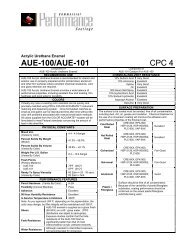MSDS_files/Velox MSDS.pdf - English Color and Supply
MSDS_files/Velox MSDS.pdf - English Color and Supply
MSDS_files/Velox MSDS.pdf - English Color and Supply
Create successful ePaper yourself
Turn your PDF publications into a flip-book with our unique Google optimized e-Paper software.
MATERIAL SAFETY DATA SHEET<br />
SECTION I - CHEMICAL FAMILY: Polyurethane<br />
NFPA HAZARD RATING<br />
POLY<br />
ISO<br />
H 2 2<br />
F 0 0<br />
R 0 1<br />
PP 1 1<br />
Degree of hazard: 4 = Extreme; 3 = High; 2 = Moderate; 1 = Slight; 0 = Insignificant<br />
SECTION II - HAZARDOUS SUBSTANCES<br />
HAZARDOUS INGREDIENTS<br />
SIDE INGREDIENT % BY WT TLV PEL Vapor Pressure<br />
ISO<br />
POLY<br />
4,4’ Diphenylmethane<br />
diisocyanate*<br />
CAS # 101-68-8<br />
Diethyltoluenediamine<br />
CAS # 68479-98-1<br />
15 – 25 0.02 ppm 0.02 ppm 0.0003 mm HG<br />
12 – 20 Not established by OSHA / ACGIH<br />
* This chemical is subject to SARA Title III, Section 313 Reporting<br />
SECTION III – PHYSICAL DATA<br />
BOILING POINT: > 300 ºF<br />
EVAPORATION RATE: N/A<br />
% VOLATILE BY VOLUME: Non-volatile VAPOR DENSITY: N/A<br />
WEIGHT PER GALLON: (QL-007 POLY 8.21 lbs.) (QL-007 ISO 9.33 lbs)<br />
SECTION IV – FIRE & EXPLOSION HAZARD DATA<br />
FLASH POINT: Non-flammable liquids.<br />
EXTINGUISHING MEDIA: Foam, CO 2, dry chemical, or water fog.<br />
SPECIAL FIRE FIGHTING PROCEDURES: Firefighters must wear self-contained breathing<br />
apparatus <strong>and</strong> full protective clothing to prevent contact with toxic <strong>and</strong>/or irritating fumes. Do<br />
not spray pool fires directly; a stream of water directed into hot, burning liquid can cause<br />
frothing.<br />
UNUSUAL FIRE & EXPLOSION HAZARD: Contamination of “ISO” component with water will<br />
generate carbon dioxide gas with possible pressure build up in confined areas. Incomplete<br />
<strong>Velox</strong> by Artlux Material Safety Data Sheet Page 1 of 3
combustion may produce carbon monoxide. These products are non-flammable <strong>and</strong> will not<br />
explode from mechanical impact.<br />
SECTION V – HEALTH HAZARD DATA<br />
THRESHOLD LIMIT VALUE: (ISO: 0.02 ppm) (POLY: N/A)<br />
EFFECTS OF OVEREXPOSURE: Skin contact may cause irritation. Eye contact causes irritation,<br />
redness, tearing, <strong>and</strong> blurred vision.<br />
EMERGENCY & FIRST AID: Eye Contact: Flush with water for at least 15 minutes <strong>and</strong> call a<br />
physician as soon as possible. Skin contact: Wash with soap <strong>and</strong> water <strong>and</strong> remove<br />
contaminated clothing. Ingestion: See a physician immediately.<br />
PRIMARY ROUTES OF ENTRY: Dermal most likely.<br />
MEDICAL CONDITIONS PRONE TO: Repeated exposure can cause allergic reaction with<br />
development of occupational asthma. Long term repeated exposure to low vapor levels may<br />
cause chronically progressive pulmonary disease. Repeated skin contact can result in<br />
sensitization.<br />
SECTION VI – REACTIVITY DATA<br />
STABILITY: Stable<br />
CONDITIONS TO AVOID: Temperature extremes <strong>and</strong> water.<br />
INCOMPATIBILITY: Avoid contact with strong oxidizing agents, water, alcohols, amines, <strong>and</strong><br />
strong bases.<br />
HAZARDOUS DECOMPOSITION PRODUCTS: Incomplete burning may produce carbon monoxide<br />
<strong>and</strong>/or carbon dioxide.<br />
HAZARDOUS POLYMERIZATION: “ISO” component reacts slowly with water to produce carbon<br />
dioxide gas.<br />
SECTION VII – SPILL OR LEAK PROCEDURES<br />
STEPS TO BE TAKEN IF MATERIAL IS RELEASED OR SPILLED: In enclosed areas, cleanup<br />
personnel should wear self-contained breathing apparatus. Cover spills with sawdust,<br />
vermiculite, or other absorbent materials to minimize spreading of the material before collecting.<br />
Do not heat or cut empty containers with electric or gas torch. “ISO” component must be<br />
neutralized with an equal volume of a 6% ammonia solution in water <strong>and</strong> allowed to react for 10<br />
minutes. Collect into open containers <strong>and</strong> add more solution. Cover loosely to vent carbon<br />
dioxide gas generated.<br />
WASTE DISPOSAL METHOD: Dispose in accordance with local, state, <strong>and</strong> federal regulations.<br />
SECTION VIII – SPECIAL PROTECTION INFORMATION<br />
RESPORATION PROTECTION: Use organic vapor cartridges with a mechanical filter to remove<br />
airborne particles. Use self-contained breathing apparatus in enclosed areas.<br />
VENTILATION (Local Exhaust): Mechanical<br />
PROTECTIVE GLOVES: Chemical resistant plastic or rubber GLOVES.<br />
<strong>Velox</strong> by Artlux Material Safety Data Sheet Page 2 of 3
EYE PROTECTION: Safety goggles or face shield.<br />
OTHER PROTECTIVE EQUIPMENT: Eye bath & safety shower should be available.<br />
SECTION IX – SPECIAL PRECAUTIONS & TOXICOLOGICAL PROPERTIES<br />
SPECIAL PRECAUTIONS TO BE TAKEN IN HANDLING & STORING: Keep containers closed <strong>and</strong><br />
store in a cool, dry place away from direct sunlight.<br />
TOXICOLOGICAL PROPERTIES: The International Isocyanate Institute is currently sponsoring a<br />
lifetime study on polymeric MDI in rats for carcinogenicity. Monomeric MDI is positive for<br />
mutagenicity in the Ames assay. Oral LD50 (rats) is greater than 15800 mg/Kg. Dermal LD50<br />
(rabbits) is greater than 7900 mg/Kg. Inhalation LC50 (rats – 2hr) is greater than 400 mg/M3 on<br />
dust of monomeric MDI. Harmful or fatal if swallowed. Vapor harmful. May cause skin or eye<br />
irritation.<br />
<strong>Velox</strong> by Artlux Material Safety Data Sheet Page 3 of 3




